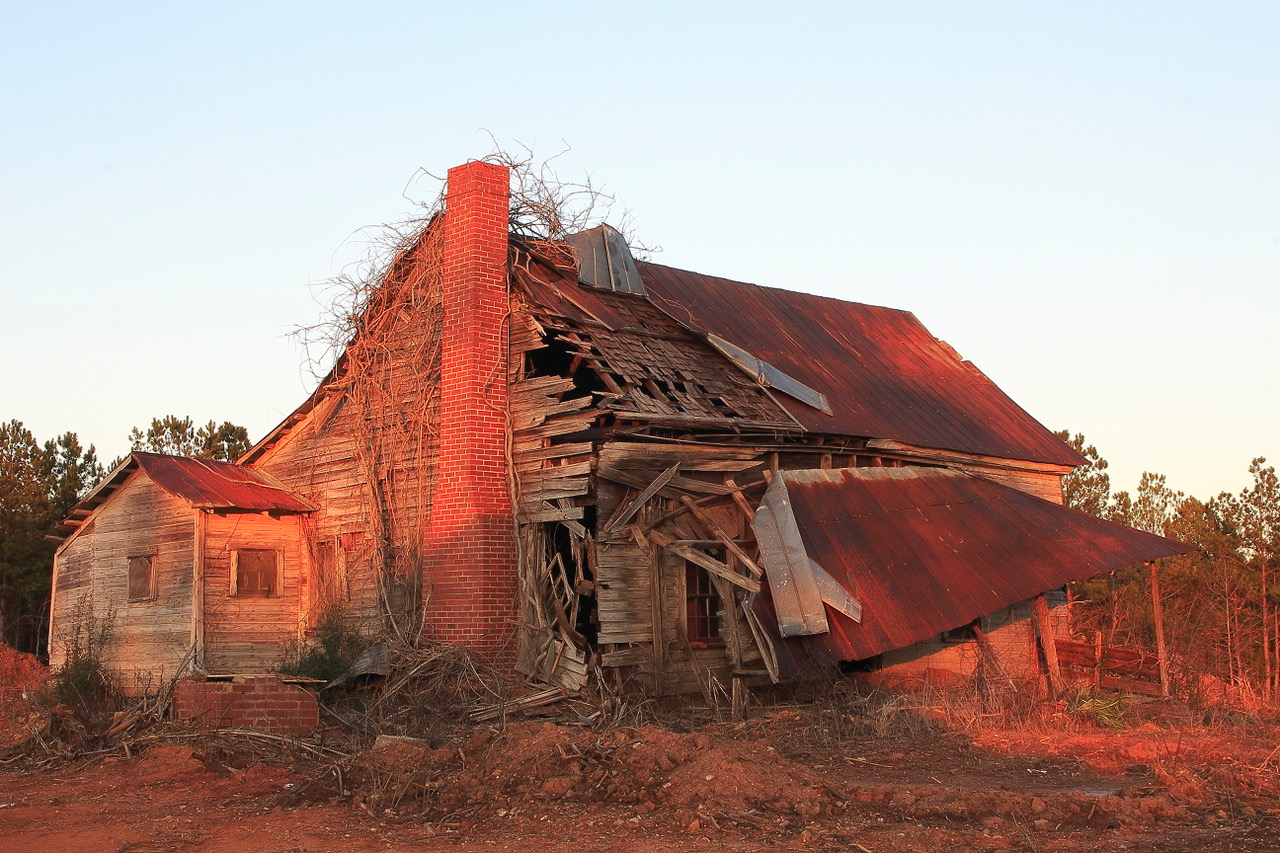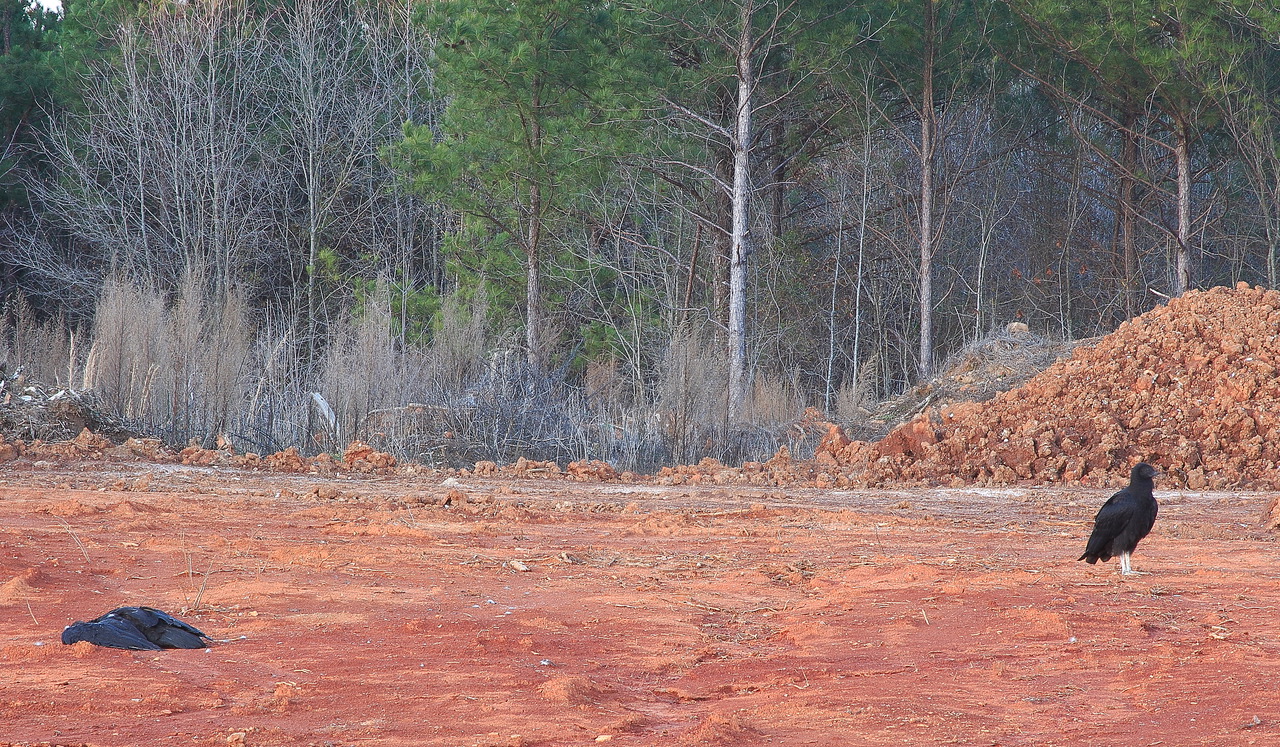Devotion At An Abandoned Home Place
February 28, 2023By Tom Poland
No matter how long, no matter how often you travel a road, it’ll surprise you. I’ve driven Highway 378 into Georgia for not quite fifty years. The road has been a journal, and some of my experiences along that highway have made it into print. Roads tell stories, if you look and listen.
Some stories tell of tragedy. I’ve come across the unimaginable “Mule Kick That Killed Eight People” in Edgefield County. Some tell of destruction. I’ve seen three stores arsonists burned along 378. Some tell of sadness. I’ve seen homes go dark when their owners died, and I’ve seen wheelchair ramps go up as the years roll by, but aging’s changes go far beyond wrinkles, silver hair, and wheelchair ramps.

Western sunlight sets on an old home’s final days.
Buildings, wildlife and aging woodlands litter Highway 378, the highway of change. Along the road, winter lays the land bare. I’ve caught glimpses of ghost bridges come cold days after billions of leaves have fallen. Such is the case with the old Hard Labor Creek Bridge, an apparition that vanishes come summer.
But now another form of revelation falls, not rises, to reveal hidden places, the cutting of forests. The rise in lumber prices has translated into felling trees, clear-cutting, and places once hidden by woods reveal themselves. You see the lay of the land and you spot structures long concealed.
Driving west on Highway 378 for maybe the 1,500th time I saw an ancient house for the first time. Just past Redemption Way stood a house on a red clay hill. Redemption Way, isn’t that a great name for the road leading to a correctional institution? There’ll be no redemption, however, for the old home. It will soon vanish. Some kind of development’s coming.
The old home had to have been magnificent in its day. It had what appeared to be cedar shingles to my inexperienced eye. Might be oak. A tin roof overlay the shingles, and a fine red brick chimney flanked the two-story home’s western side. As aged as it was, the house looked solid.
Details began to catch my eye. In a window partially covered by a collapsed tin overhang I saw a red curtain and scrap of cloth, red also. And red sunlight struck the old house as the winter sun hovered just over the horizon. What held my eye, however, were two birds black as coal.

In sickness and health, a faithful buzzard waits.
To the left of the home, northwest as the compass goes, were two buzzards. One was standing by its fallen mate. (To my surprise I learned that buzzards mate for life. So, I’m assuming they were more than feathered friends.) The buzzard maintaining a vigil, I’ll say, did not flee as I approached. It hopped several yards from its fellow buzzard and kept a wary eye on me. Its mate lay on the ground with its left wing appearing broken. The fallen buzzard was dead, or so I thought. Buzzards can play possum; this one did. As I backed away, I saw its head lift.
I respect buzzards. From boyhood times when hundreds of them circled over pastures back home, I’ve paid attention to them. Reviled and deemed repulsive by others, just where would we be without buzzards?
I don’t see them in numbers like I once did though I recall seeing a large wake of buzzards pull at a deer carcass along 378. Their hunched black-shoulders brought shabby-dressed pallbearers to mind.
The original ornithologists, the Cherokee, understood buzzards. According to Cherokee legend, buzzards beat their wings in unison after the great flood. They dried all the mud and their synchronous wing beats carved out the valleys and mountains of Appalachia.
Buzzards and death go together. Buzzards like to perch in dead trees. They love dead houses too and I will surmise that they love their mates, maintaining a vigil, as this one seemed to do. Devoted and protective it seemed. The experts claim buzzards don’t eat fallen comrades, so suppress the cynic in you. Give the carrion-eating buzzard some credit for being a bit civilized, for having, if you will, a touch of humanity.
Georgia native Tom Poland writes a weekly column about the South, its people, traditions, lifestyle, and culture and speaks frequently to groups in the South. Governor Henry McMaster conferred the Order of the Palmetto upon Tom, South Carolina’s highest civilian honor, stating, “His work is exceptional to the state.” Poland’s work appears in books, magazines, journals, and newspapers throughout the South.
Visit Tom’s website at www.tompoland.net
Email him at [email protected]



















